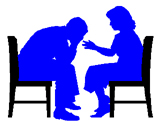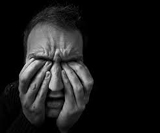Notes on counselling
Psychological aspects of pain management — a consciousness approach
Abstract
Though pain is inextricably linked with emotions and thoughts, the resistance of the physical plane makes psychotherapeutic interventions merely palliatives. Arousal of the subtle body-consciousness would offer better ways to deal with pain. Instead of dealing with isolated emotions, increasing the repertoire of life-energy can be beneficial. On the mental plane, as subjects err more on positive self-assessments, mindfulness techniques strengthen coping strategies more than cognitive-behavioural methods. Finally the rasa or inner essence of dualities of pain and pleasure can be linked with Ānanda or Bliss-principle.
Pain is one of the most enigmatic aspects of life and its psychological associations not only include distress and suffering but also anguish and remorse, nostalgia and grief and sometimes may be associated with love as well as guilt. This is why pain has not only been dealt with by therapists but also by littérateurs, artists, musicians, religious preachers, philosophers and mystics. Yet one fact always remains true, that whatever be the non-physical concomitants of pain and whatever counselling or psychotherapy we may indulge in, the final common pathway through which pain is expressed and also needs to be tackled is the body.
The physical plane of consciousness
The body is indeed the battlefield where all our stresses and strains, conflicts and complexes, joyous moments and tragedies find their ultimate medium of expression. What makes matters more complicated is that the physical plane of consciousness, which is represented in the body, is very resistant to shearing forces and lacks the flexibility and malleability of the non-physical planes. In a way this has a great advantage, for the physical plane can provide a stability and durability to our existence. In another way, it has a disadvantage. For a habit that gets imprinted here can be very difficult to be shrugged off by overcoming the resistance of Matter. Pain as a maladaptive habit gets consolidated with structural mal-alignments, such as postural imbalances in conditions like scoliosis or deformities in conditions like arthritis. Such habits often get reinforced by psychological conflicts and repressed issues. In chronic pain syndromes, pain becomes for all practical purposes an obstinate habit and even though exaggerated by psychological conflicts, all our high-sounding psychotherapeutic or counselling techniques can do little except to act as palliatives and adjuncts (not much different from antioxidants and pregabalin!) that at best help one to bear the pain.
Any deep psychotherapy would ask this pertinent question — can mental will-power be used to give a suggestion to the body? We find this happens typically to infants who immediately accept the suggestions of their mothers and forget pain. An infant, who has learnt to walk, tumbles over and gets hurt but the mother rebukes the floor and tells the child that nothing has happened — a suggestion that like a guarantee is immediately accepted with conviction and faith. In adults such a situation can be transiently created for remedial action during hypnotherapy but here also the suggestion comes not from the affected subject but from the therapist. There are hathayogic exercises where one learns to give suggestions to one’s own body but these suggestions are generally aimed to improve health; they are not used directly to heal ailments. A new integral approach to consciousness expounded by Sri Aurobindo takes up this challenge and works its way to unveil a latent and dormant body-consciousness in the subtle physical plane. This subtle body-consciousness can actually be activated which can then be used for healing oneself or others. Sri Aurobindo asserts that “there is a body-consciousness which can do things at the mind’s order, but has to be awakened, trained, made a good and conscious instrument. It can even be so trained that a mental will or suggestion can cure the illness of the body (1).” The Mother took the exploration of this body-consciousness to great depths. One normally describes that a harmonisation of the discordant parts of one’s being needs a surpassing of the ego which handles emotions, desires and ideas in a skewed way. The Mother in her extensive exploration of the body-consciousness also surpassed the physical ego which is the entity that holds the physical frame together so as to maintain individualisation without the ego’s limits; in a way “what we may call the raison d’être [of individualisation] comes back, and without the ego’s limitations (2).” It was a very risky task as it needed to be executed in a state of transition between the zone of life and the zone of non-life which she described as “a moment when it’s neither this nor that, and that moment is critical (3)”. An activation of the body-consciousness while surpassing the physical ego made the body susceptible for transformative and mutant effects that automatically carried self-healing prowess.
The vital plane of consciousness
The physical plane of consciousness is animated by life-energy or élan-vital that holds the repertoire of our emotions. Emotions modulate our pain perception and pain behaviour and some subjects with chronic pain develop concomitant depression. Conversely, some types of pain can also be a manifestation of depression. We still do not actually know if depression is initially caused by pain or whether depression increases pain. It is very interesting that anti-depressants are used in the treatment of chronic pain even if depression is not present. We of course still do not know whether anti-depressants are effective in depression due to their action through neuro-transmitters. But it is a fact that any psychiatric clinic has, besides the somatisation disorders (which thrive without organic basis), its organic quota of low-back pain, radiculopathies, neuropathies, migraine, facial pain, pelvic pain, atypical genital pain and arthritis that all get varied amounts of relief from anti-depressants even without satisfying the diagnostic criteria of depression. In the Āyurvedic tradition however, all diseases are psychosomatic in nature with every individual being assessed simultaneously along psychological dimensions (the guṇas) and the somatic dimension (the doṣas). Various combinations of guṇas and doṣas are considered to underlie various diseases. Perhaps such a diagnostic model would better explain why anti-depressants can be beneficial in chronic pain with no visible clinical depression.
The consciousness perspective of psychology works in a novel way. Instead of analysing isolated emotions and relating them with pain, it recommends a rejuvenation, widening and upliftment of the vital energy, life-force or élan-vital that is the repository of our emotions, many of which are conflicting and contradictory to each other. There are several techniques that align the individual energy (Pranic Śakti) with the universal life-energy and then link the collated individual-universal energy with the transcendental or spiritual fountain-head of energy (4). This combination helps the subject to open oneself to universal healing energies. Such an endeavour would augment healing benefits derived at the physical plane whether by medicinal or naturopathic interventions.
The mental plane of consciousness
The mind manifests in the evolutionary schemata when the life-energy has animated the physical plane to an optimal point. It is natural therefore that our cognitive styles can get associated with emotional responses to produce different behavioural patterns. In the case of chronic pain, a negative cognitive connotation may get associated with a maladaptive emotion to produce what is known as an exaggerated and negative mental-set. This negative cognitive-affective response to pain is known as ‘Pain-Catastrophising’ in contemporary parlance. Pain-Catastrophising magnifies both real and anticipated pain, causes anxiety, depression, pessimism, helplessness, rumination and is associated with decreased response to pharmaco-therapeutic intervention and worsens post-operative pain. There are disorders like temporomandibular muscle and joint disorders (TMJD) where both depression and Pain-Catastrophising act together to increase the degree of disability. Pain-Catastrophising is less in the presence of positive emotions like hope and optimism. Even children are not immune in whom depression with negativity and hopelessness get correlated frequently with abdominal pain. Pain-Catastrophising leads to a fear-avoidance model which can become more vicious than the catastrophising itself. Chronic pain can lead to fear of movement or kinesio-phobia that can become quite incapacitating. Finally, unremitting pain may push a subject to opt for voluntary euthanasia wherever that option is available.
Cognitive Behaviour Therapy (CBT) used in chronic pain syndromes is effective but has its limitations. This is because while the subject focuses on negative attributes, his or her positive evaluation of the self is usually inaccurate. From the consciousness perspective, this is understandable. One can focus on one’s negative attributes from one’s rational poise. But to observe one’s positive attributes, even one’s rational overtures need a poise stationed above one’s rational mind. Not surprisingly, positive self-assessments that arise during cognitive therapy are very often erroneous, dysfunctional and maladaptive, bordering on a veiled ego-satisfaction. In a way, mindfulness-based stress reduction exercises (MBSR) employing exercises like meditation, relaxation, yoga, body scanning, positive thought reinforcement and widening experiences are non-controversial and improve pain parameters and health-related quality of life measurements (HRQoL) and increase effectiveness of any pain treatment module.
The inner realms of consciousness
From the consciousness perspective, any understanding is incomplete unless it addresses the inner realms that hold the fourth-dimensional central principle or soul-essence of the being. The Indian tradition holds that the intrinsic essence of the dualities of pain and pleasure is the actual rasa that has to be deciphered and perceived at the inner realms of consciousness so as to get linked with the Bliss-principle or Ānanda of the quintessential Indian metaphysical tradition. This Ānanda is the value aspect of the Supreme Reality or Sachchidananda and upholds all existence and gives meaning to life. Ānanda is a non-motivational sui-generis principle that is independent of all dualities and its realisation has not only given aspirants solace and strength to bear pain and suffering with magnanimity and equipoise but has also helped them to transform pain into pleasure.
In the Indian spiritual tradition, every maladaptive event in life can be turned into a stepping-stone for a personal growth in consciousness. This is because every manifested thing is considered to be a projection of a higher Superconscious Unmanifest Archetypal Reality which gets deformed, distorted or deviated in creation. Thus eternal life becomes death in creation, the knowledge of unity becomes the ignorance of diversity and the essence of everlasting love becomes the nodal point of hatred and envy. Likewise the principle of unalloyed pleasure becomes the anguish of unremitting pain. However the Indian tradition also experientially realised that as the macrocosm was represented in the microcosm, the microcosm also had the potential to be represented in the macrocosm. This is both the metaphysical and psychological justification of why, despite our limitations within a space-bound and time-bound reality, the human aspiration can move towards the Eternal Reality beyond space and time. If this is so, we must accept the experience of seekers and mystics that the principle of pain can be sublimated into the principle of unconstrained pleasure against the gestalt of Ānanda, the motiveless Bliss that alone gives meaning to existence and life.
From the physiological perspective, pain serves an important signal and protector of our bodily system. But for its presence and timely warning, we would miss the enormity and gravity of threatening wounds, traumas and ulcers which could lead to even greater fatality. From the consciousness perspective, pain serves an evolutionary purpose. Pain indicates an imperfection in the being, a breach in the integrity, a lacuna in the armour. Pain comes with a message that it has to be overcome for restoring the equipoise of the being. Pain awakens us to our defects and insincerities, our lapses and shortcomings and stimulates us to seek for pleasure and even poise beyond pleasure – a poise that culminates in the sojourn for Bliss or Ānanda. It is because of the presence of pain that the science of medicine blossomed. It is because of pain stimulating the human being to make a life-review that a need for introspection arose, a need to consider one’s lapses so as to make the necessary correction to move forward. Even if the suffering of pain leads to depression and often to nihilism, it is also the metaphysical value of pain that makes one to rise above all imperfection, to opt for the saga of salvation, the void of Nirvana or the Bliss of the spiritual plenitudes. Sri Aurobindo pens down graphically:
“The spirit is doomed to pain till man is free. There is a clamour of battle, a tramp, a march: A cry arises like a moaning sea, A desperate laughter under the blows of death, A doom of blood and sweat and toil and tears. Men die that man may live and god be born. An awful Silence watches tragic Time. Pain is the hand of Nature sculpturing men To greatness: an inspired labour chisels With heavenly cruelty an unwilling mould (5).”
References
1. Sri Aurobindo. Birth Centenary Library, Volume 22. Pondicherry: Sri Aurobindo Ashram Trust; 1970, p. 324.
2. The Mother. The Mother’s Agenda, Volume 9. Paris: Institut des Recherches EEvolutives; 1995, p. 44.
3. Ibid., p. 46.
4. Basu, S: Integral Health. 2nd Ed. Pondicherry: SAIIIHR; 2011, pp. 92-8.
5. Sri Aurobindo. SABCL, Volume 29. 1970, p. 444.
Dr. Soumitra Basu, a practising psychiatrist and member of SAIIIHR, is the Director of a school of psychology, Integral Yoga Psychology. He is also one of the editors of NAMAH.
Sharmila Basu is a clinical psychologist based in Pondicherry.
Share with us (Comments,contributions,opinions)
When reproducing this feature, please credit NAMAH,and give the byline. Please send us cuttings.






